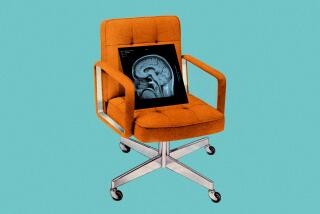Brain Teaser: What Makes Up Our Minds?
- Share via
What makes people smart?
It is a question that scientists and philosophers have pondered for centuries, prompting complex calibrations, from head measurements to brain-bending tests.
Yet the drive to probe the powers--and the limits--of the human mind has been thwarted by the hard facts of life: The brain was virtually a black box, its inner secrets locked within.
Now, scientists are using the latest technology to peer inside. Using machines such as the PET scanner, which maps the brain’s use of energy, researchers at UC Irvine and elsewhere are producing among the first images of how gifted, and not so gifted, minds go about the task of thinking.
What they see not only intrigues them, it sometimes surprises and stumps them as well.
Why, for example, should male and female math wizards, matched in ability, seemingly use different brain mechanisms when solving problems? Why, when certain mentally disabled people take intelligence tests, do they show more brain activity than those of average intelligence rather than less?
“We’re just beginning to find out what all of this means,” said Richard Haier, a professor of pediatrics at UC Irvine, who came up with the tantalizing findings. The more the field of intelligence is studied, he said, “the more complex it becomes.”
These days, the very idea of intelligence is up for reconsideration. Some researchers are calling for broader measures, and a broader view, of the mind’s potential. Even emotional skills, once considered entirely separate from intellect, are being proposed as key components of human brainpower.
For years, scholars have haggled over whether smarts can be summed up as a single entity, as in an intelligence quotient, or a collection of interacting capabilities, or perhaps many distinct skills.
“We don’t want to be evaluating people on one thing, which is turning out to be a very narrow and prejudicial concept of cognition,” said Harvard psychologist Howard Gardner. “A lot is based on IQ and SATs, and it’s malpractice as long as we know the mind is much more complicated.”
Gardner argues that humans have at least seven different types of intelligence, from “mathematical-logical” to “interpersonal.”
Of late, the concept of so-called “emotional intelligence” has taken off, both in the realm of science and in the public imagination.
Proponents of this idea don’t necessarily consider IQ the best predictor of how one will fare in life. What about empathy, intuition and social savvy? It’s not the same as a knack for numbers or polysyllabic expression; some astounding intellects have trouble being civil, let alone suave. Yet, certain emotional skills seem to bring success: promotions and coveted invitations, for example.
Some argue that emotion should not be considered separately from intellect. Often, feelings sharpen reason, says University of Iowa neuroscientist Dr. Antonio R. Damasio. Emotion helps reason to focus the mind, to set priorities.
Even those who consider IQ the best measure of overall intelligence acknowledge that we are only beginning to understand what, inside our heads and out, accounts for its highs and lows.
UCI’s Haier, in a series of pioneering studies, has used brain imaging to probe the neural underpinnings of intelligence, as traditionally assessed by IQ and Scholastic Assessment tests (SATs.)
Only recently have researchers had the tools for the expedition: the Positron Emission Tomography (PET) scanner, first used in research about 1980, and in the past few years, functional magnetic resonance imaging (FMRI) machines, long tubal magnets that map changes in the brain’s blood flow.
The work at UCI and scattered research centers across the country still is in its infancy, but some scientists already speak glowingly of its promise. The technology has potential in the field of education, for example, raising the possibility of someday tailoring instruction to the capabilities of individual minds.
“It is truly breathtaking what the possibilities are,” said Craig Ramey, an Alabama psychologist who has studied intelligence and learning for more than a quarter century.
Eventually, intelligence researchers hope their findings will lead to a better understanding of mental disabilities such as Down’s syndrome, learning disorders such as dyslexia and even memory loss associated with old age.
“I’m focusing on how to fix broken brains,” Haier said. “The most wonderful thing that could come out of this is research is the treatment and prevention of mental retardation.”
These instruments “give us a window into the brain that we didn’t have before,” said Cleveland psychologist Douglas Detterman, editor of the journal Intelligence. “There’s been so little work done. . . . Initially, what is going to be interesting is just exploring the continent.”
There is some disagreement about how best to proceed--whether it is best to scout the territory in pieces or cover the entire frontier.
A growing number of researchers nationally are using brain scans to study specific cognitive processes, such as working memory, that are thought to be major components of intelligence. Often, they seek to apply what they learn to specific dysfunctions.
Haier is among the first to start with the big picture.
“In my mind, all of this research on the various cognitive processes eventually can be understood in some unified theory of intelligence,” he said.
His quest began in 1988, when he took volunteers and gave them a standardized abstract reasoning test. He expected that some parts of each person’s brain would light up more than others, showing which areas were most engaged. Instead, he said “we found something very dramatic and very surprising.”
The brightest subjects--as identified by the reasoning test--had the lowest metabolic activity overall, he said. That gave rise to what he dubbed the “brain efficiency hypothesis,” which has formed the basis for his subsequent research and sparked other studies around the country.
The essence of the idea--which still is being tested--is that brighter people have lower metabolic rates because their brains are more efficient. Haier speculated that less bright people might be using inessential, or even detrimental, circuits.
A follow-up study bolstered his theory. Haier’s group compared the PET scans of mildly mentally disabled people with subjects of average intelligence. Sure enough, the mentally disabled showed higher metabolic activity when doing the same mental tasks.
But the brain’s machinations, it seems, are more complex than Haier’s original hypothesis suggested. In a later study, his group found that when bright people are given harder tasks, tailored by computer to their abilities, their brains worked harder than the average person’s. Apparently, brain activity depends, to some extent, on the difficulty of the task and level of effort required.
Haier surprised himself again when he discovered that men’s and women’s minds functioned differently--even when they had the same mental abilities.
He and Iowa researcher Camilla P. Benbow compared PET scans of mathematically talented students--as determined by the SAT--to average students. He expected to find some measurable difference in brain activity between the gifted and the not-so-blessed.
Instead, his most striking finding was overall gender differences. Among the men doing math problems, a part of the temporal lobe consistently lit up; the more it lit up, the better they scored on the math test. Among women, however, no such pattern emerged: The average and gifted women showed no significant difference in temporal lobe activity.
What gives? Haier’s short answer is, “We don’t know.”
But he suspects that men’s brains are more focused in their mathematical thinking than women’s. The talented females simply may be more efficient than their average peers, rather than more focused.
All this research assumes that IQ and SAT scores say something important about a person’s intellectual potential. But these scores won’t tell you who can best work a crowd or who will have the most friends--and Haier freely admits that.
The question is, are these emotional skills a completely separate sort of smarts?
Haier thinks not.
He believes emotional intelligence is correlated with IQ, and is one component of overall intelligence. IQ, he says “is the strongest single predictor of general intelligence, with emotional intelligence a close second.”
University of New Hampshire psychologist Jack Mayer, one of two scholars to propose the theory of emotional intelligence, thinks this may be an ability distinct from general intelligence. He got the idea in graduate school, where he watched artists and engineers struggle to communicate.
“Both were quite intelligent,” he said, “but some artists couldn’t understand logical thought and . . . some engineers couldn’t understand what all the buzz was about emotions,” Mayer said.
“It began to dawn on me . . . that emotions convey important pieces of information. If we can say there is a spatial ability to get information from grids and diagrams, maybe there is an intelligence that allows people to get information from social interactions.”
If this intelligence exists, it is exceptionally hard to define, let alone quantify. It’s not a matter of asking someone to assemble a puzzle or to define a word.
“Getting a pure, ideal measure is somewhere in the future. . . . There isn’t a lot of research on it yet,” said Mayer, who is working on these assessment tools.
Can the new technology, these brain periscopes, be applied to “emotional intelligence”? Theoretically, they can, insofar as this intelligence can be measured and defined.
Take a simple case like facial expressions. University of Pennsylvania researcher Ruben Gur has shown that women are better than men at detecting sadness on the faces of female actresses; brain imaging showed men had to work harder to get the right answers on the test. This doesn’t mean women are emotionally sharper than men--but it is one way of assessing a particular emotional skill.
Some researchers, like Gardner, predict neuro-imaging will show each form of intelligence involves different parts of the brain.
Other scientists believe that technology will not provide such neat answers; it will, however, give us a glimpse of the mind’s vast complexity.
“People seem to like to attach [the word] intelligence to a lot of things,” said Detterman. But “psychology has been too atomized in the sense that it divided intelligence, motor behavior and emotion into different areas. I think there is a lot of relationship between” them.






